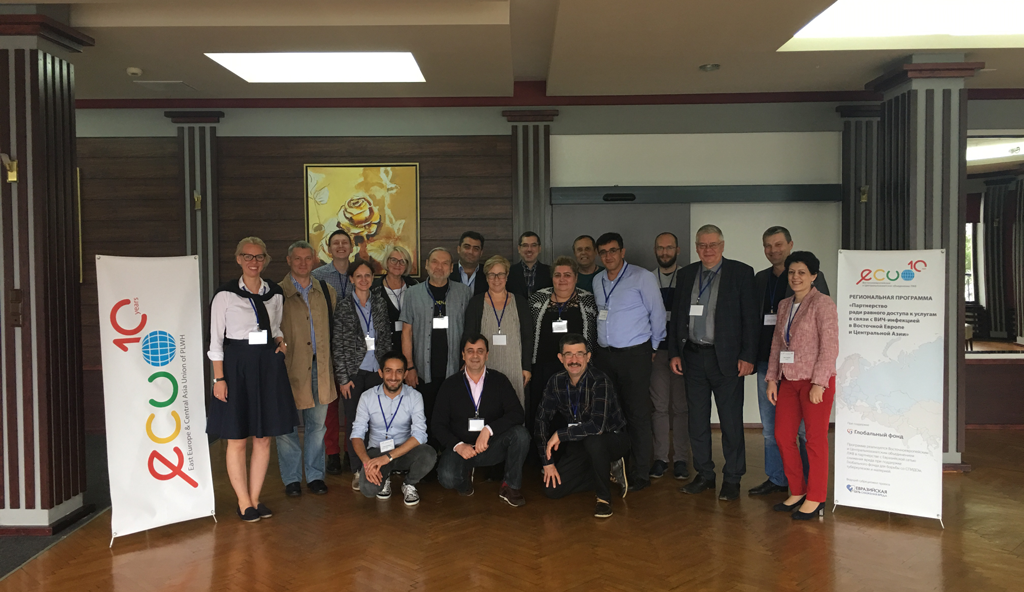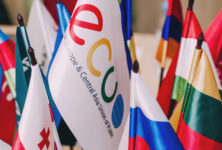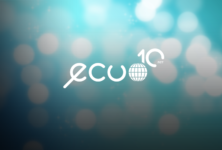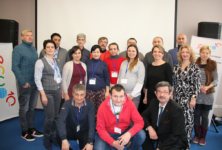In early September, Poland became the platform for the first presentation and discussion of the “Concept of the East Europe and Central Asia Union of People Living with HIV on access to treatment in the EECA region”. The key aspect of the Concept is the expansion of access to modern ARVs in the countries of the East Europe and Central Asia.
The discussion was attended by the representatives of public health institutions of Belarus, Azerbaijan, Russia, non-governmental organizations in East Europe and Central Asia, as well as representatives of respectful international organizations involved in responding to the HIV/AIDS epidemic, including: the Global Fund, the World Health Organization, UNAIDS , Médecins Sans Frontières, GNP+, Medical patent pool, Positive Voice, Eurasian coalition on male health (ECOM) , Center for health policies and studies (PAS), The European AIDS Treatment Group (EATG).

Vladimir Zhovtyak, President of ECUO: “At the working meeting of ECUO in Poland, we discussed the concept of our advocacy concept on access to HIV treatment with innovative drugs, as a prerequisite for ending the epidemic in our region. While developing the concept, we relied, first of all, on the latest recommendations of the World Health Organization, published in July this year, as well as on recent studies of leading European and American scientific and medical centers that recommend integrase inhibitors as the preferred drugs in the first line HIV treatment. We insist that the life quality of patients is the most important condition to combat the HIV/AIDS epidemic! The countries of Eastern Europe and Central Asia are Europe! And in Europe, there should be neither double standards in the treatment nor discrimination of HIV-positive people in access to the entire care continuum!”
George Sakvarelidze, a senior portfolio manager of the Global Fund, joined the participation online. In his welcoming speech, he underscored the Global Fund’s interest in implementing the ECUO advocacy concept in response to the HIV/AIDS epidemic in the EECA region and expressed support for the ECUO efforts aimed at expanding access to HIV treatment with innovative drugs.
At the meeting, it was noted that ECUO welcomes the “Test&Treat” strategy, similarly to other prestigious international organizations. To combat the HIV/AIDS epidemic in the EECA region, it is necessary to provide treatment right away, when a person is diagnosed with HIV infection, to avoid its rapid development in the body, and further spread.
Along with the availability of treatment, to ensure the effective response to the HIV/AIDS epidemic in all countries of the EECA region, the issue of adherence to treatment and the availability of quality, effective and modern ARV drugs, with the least side effects, is topical. The obvious remains the fact that if the quality of human life significantly worsens from the medicines, he/she will certainly stop taking such medicines. Which in its turn will contribute to further spread of the HIV/AIDS epidemic and the development of resistance to certain drug formulas.
Masoud Dara, Communicable Diseases Programme Manager “Joint TB, HIV/AIDS and hepatitis”, WHO, in his presentation described the priorities of the organization: “In the WHO European Region we experience the fastest growing HIV infection. In our region, 40,000 AIDS-related deaths are recorded each year. In addition to comprehensive HIV testing policies and practices, WHO strongly recommends considering all human-centered approaches. It is critical to eliminate the gap in the treatment of all, by ensuring the efficacy and safety of drugs using as many generic drugs as possible, taking into account the specific treatment of children, pregnant women, people affected by TB/HIV co-infections. WHO emphasizes the recommendation to use fixed-dose combinations and intake of drugs once a day to improve adherence to treatment. The general pre-exposure prophylaxis (PrEP) containing Tenofavir (TDF) should be offered as an additional prevention option for people at high risk of contracting HIV as part of combined approaches to HIV prevention. In July 2017, WHO issued new recommendations on treatment and drug resistance, which will be translated into Russian. According to them, Dolutegravir (DTG) and Efavirenz 400 mg (EFV400) are recommended for the first-line therapy, Darunavir/Ritonavir (DRV/r) and Raltegravir (RAL) for the second and third line therapy. The regimens supporting the DTG and EFV400 have clinical and programmatic advantages over the existing standard first-line ARV-drugs, but for particular population groups, a large evidence base is required.
There is a need for constant dialogue to optimize treatment regimens and reduce drug prices”.
Some of the countries of the region have already made confident steps towards overcoming the epidemic, but in most countries, modern, innovative dosage forms remain inaccessible. In all countries of the EECA region, the epidemiological situation differs, but all PLHIV need the same: access to treatment with effective drugs and minimal side effects that ensure life quality.
The ECUO highly values the united community efforts in response to the HIV/AIDS epidemic and the support of international organizations whose representatives have joined the discussion of the regional advocacy campaign in Poland.
Esteban Burrone, Head of Policy, Medicine Patent Pool (MPP), presented the report on the activities and priorities of the organization, indicating that the foundation of their strategy is to expand access to innovative drugs. In this, of course, the objectives of the ECUO and MPP coincide. He shared the information about the role of MPP in the transfer of patents in the EECA region, talked about the current negotiations with the generic and brand pharmaceutical companies, and about the countries where the license is being transferred. Esteban Burrone paid particular attention to MPP plans to expand access to integrase inhibitors and replace TDF with TAF.
Asker Ismayilov, Regional (EECA) TB Advocacy Coordinator, Medicines Sans Frontiers (MSF), noted fruitful cooperation with the ECUO for 10 years. In his report on the role of MSF in the promotion of innovative drugs in the EECA region, he spoke about the existing approaches to the formation of drug prices, peer assessment by MSF, indicating that to achieve universal access and to achieve 90-90-90 targets of the UNAIDS strategy, the cost for treatment course for HIV, TB and hepatitis per 1 patient should not exceed $90 across the region.
Naira Sargsyan, UNAIDS Regional Adviser: “East Europe and Central Asia is the only region in the world where the HIV epidemic continues to grow. Currently, only 45% of people living with HIV who are aware of their HIV status, are on antiretroviral (ARV) treatment. Unfortunately, in most cases, treatment is prescribed at the late stages of infection. The ECUO working meeting in Poland allowed discussing the situation regarding access to HIV treatment, including innovative drugs, as well as getting acquainted with the ECUO’s new advocacy concept to expand access to innovative drugs in the region.
UNAIDS supports the advocacy efforts of the ECUO and other non-governmental organizations aimed at increasing access to ART, following the latest WHO recommendations, which state that HIV treatment should be provided to everyone with HIV, regardless of their immune status.
All those who live with HIV have the right to receive quality and timely treatment. The execution of this right is one of the prerequisites for ending the epidemic in our region and requires the joint efforts of governments and civil society”.
Gennady Roshchupkin, Technical Support Coordinator, Eurasian Coalition on Male Health: “In most countries of East Europe and Central Asia, governments do not provide people living with HIV with antiretroviral therapy, as well as other necessary medical and psychosocial assistance, citing the lack of funds in the budget. Not mentioning the prevention!
I think that innovative drugs should be available, but they can not be considered as the basis of the entire HIV treatment program. Innovative drugs must necessarily be available for children, pregnant women, people with resistant HIV strains, and for those with many concomitant diseases, those that affect the nervous system, liver, kidneys… But the basis for purchases should be inexpensive drugs both branded and generic. Otherwise, there will be not enough funds for everyone. Another important topic is the availability of ARV-drugs for pre-exposure prevention. These drugs, definitely, should be of high quality, with minimum side effects.”
Laurel Sprague, Executive Director, the Global Network of People Living with HIV (GNP+), spoke about the role of the GNP+ in advocating access to treatment, emphasized the urgency of discussing the ECUO concept and noted that access will be possible through: “Expanding access to testing, so that people knew their status; improving access to non-discriminatory and stigma-free medical facilities; availability of drugs under reasonable prices and diagnostics for all people living with HIV”*.
Afet Nazarli, Head of the Epidemiological Department of the AIDS Center at the Ministry of Health of Azerbaijan: “The ECUO through its coordination work removes the boundaries between the public sector and NGOs. After all, we individually perform the same work, but together this work is much more efficient, and will bring more positive effect and good results”.
Jaroslav Kuntsevich, Procurement Specialist of the Grant Management Office, the Global Fund of the Republican Scientific and Practical Center for the Medical Technology, Information Technology, Management, and Health Economics: “The regional meeting, initiated by the ECUO, showed how important it is to take into account the opinion of the PLHIV community. Since 2018, the Republic of Belarus will provide treatment to all with HIV-positive status. The decision on universal access to treatment is an important step towards achieving the 90-90-90 targets. However, to achieve these targets, it is also necessary to provide access to effective drugs, since, without adherence to treatment, it is impossible to take the epidemic under control. Therefore, it was essential to hear the opinion of the PLHIV representatives about the drugs used in treatment, and the ECUO initiative plays a key role in this direction. I think both the state, the patients, and international organizations are all responsible for the HIV situation in the region. Therefore, the adoption of a common regional strategy on access to treatment, which will take into account the interests of all parties – is a major step towards achieving the 90-90-90 targets”.
Oleg Yurin, Deputy Director of Clinical Affairs of the Federal Scientific and Methodological Center for AIDS Prevention and Control, FBIS “Central Research Institute of Epidemiology”, in the framework of his report at the meeting said:
“In Russia, the created centralized system for the epidemiological HIV surveillance, a system for monitoring and treating patients, as well as a set of registered antiretroviral drugs allows for individual selection of optimal treatment regimens for each patient and control over the effectiveness and safety of therapy. However, there is a range of issues that not only hamper the achievement of the targets of 90-90-90 strategy but threaten to worsen the situation. These problems require the attention of patient communities and efforts to overcome them”.
The most significant of these problems are:
- The growth in the provision of medical care lags behind the growth in the number of people who need it.
- The issue of treatment of external, and in some regions, internal migrants is not solved yet.
- The prohibition of substitution therapy makes it difficult to treat HIV among drug users.
- The declared in clinical recommendations priority of the use of combined drugs is not respected because it is not supported by the Ministry of Health and the Federal Antimonopoly Service.
- The complex bureaucratic procedure of including drugs to the list of essential medicines delays the introduction of new drugs.
- The broad introduction of generics has reduced the cost of ART, but the issue of monitoring their quality has not been resolved.
- The policy of approaching Russian national recommendations to the WHO recommendations worsens the quality of patients’ treatment.
- The development of human resources and equipping AIDS centers lags behind the growth in the number of patients.
- Russia has established a system of extensive HIV testing and a centralized surveillance system over this infection.
- A system of medical supervision and treatment (including ART) has been established. It is possible (with a sufficient number of qualified specialists) to select the optimal therapy regimens for each patient and evaluate their efficacy and safety”.
Thanks to the expressed interest and active involvement in the working meeting, the international partners exchanged the current strategic information necessary for an effective response to HIV/AIDS in the EECA region. The ECUO concept on access to treatment was presented, an advocacy campaign was discussed, feedback was received during the expert discussion and constructive criticism. Shortly, the ECUO will present an advocacy action plan for the use of innovative drugs in HIV treatment in the countries of our region.
The countries of East Europe and Central Asia are Europe! And in Europe, there should be neither double standards in the treatment nor discrimination of HIV-positive people in access to the entire care continuum!
The working meeting was held within the framework of the regional program “Partnership for equitable access to the HIV care continuum for all who need it in the EECA region”, implemented with the support of the Global Fund.
___________________
*Laurel Sprague, Global network of people living with HIV (GNP+): «In the presentation on the role of the Global Network of People Living with HIV (GNP+) in Treatment Advocacy, GNP+ highlighted the importance to recognize that treatment access requires: 1) access to testing so that people know their status; 2) access to non-discriminatory and stigma free health care facilities; and 3) consistently available and affordable medications and diagnostics for all people living with HIV».


 ПОИСК ПО САЙТУ
ПОИСК ПО САЙТУ  поиск по ресурсному центру
поиск по ресурсному центру 



